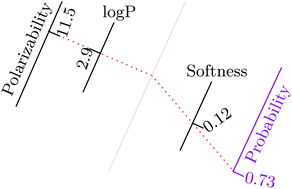Coupled molecular design diagrams to guide safer chemical design with reduced likelihood of perturbing the NRF2-ARE antioxidant pathway and inducing cytotoxicity†
Abstract
The NRF2-ARE antioxidant pathway is an important biological sensing and regulating system that responds to xenochemicals. NRF2 senses chemically-caused production of reactive oxygen species (ROS) and electrophilic interactions with chemical species. Upon NRF2 activation, the expression of a wide array of genes will be upregulated to counteract oxidative or electrophilic insults. However, when the external disruption exceeds the inherent resilience of the biological system, cellular damage can occur, eventually leading to cytotoxicity. Induced NRF2 activity in in vitro assays is therefore a signal that a man-made chemical may cause unwanted cellular activity. This was the motivation to derive a chemical design strategy to minimize the risk that new chemicals would perturb this pathway. We constructed a logistic regression model using design variables derived from density functional theory (DFT) calculations and physical properties. The model showed excellent predictive power to distinguish between NRF2-active and inactive chemicals based on the EPA ToxCast high throughput screen (HTS) assay data (tested in the concentration range of 10−3–102 μM). External evaluation showed that the area under the curve (AUC) for the receiver operating characteristic (ROC) of the model is 0.81 and the precision is 0.90. Combining this model with a previously developed cytotoxicity model, we developed a probabilistic design diagram to guide chemical design with the twin goals of minimizing NRF2 antioxidant pathway activity and cytotoxicity. This work initiated a simultaneous design strategy against two toxicity pathways of interest in molecular design research.


 Please wait while we load your content...
Please wait while we load your content...